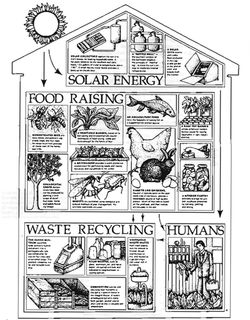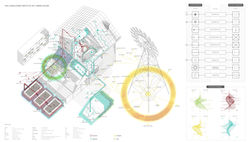 |
|---|
 |
 |
 |
 |
 |
 |
 |
|---|
 |
INTEGRAL URBAN HOUSE

Helga and William Olkowski, Sim Van der Ryn Berkeley, California, 1974
WHAT HAPPENS TO A SELF SUFFICIENT HOUSE IF ITS OCCUPANTS LEAVE?
The Integral Urban House was initiated by Helga and Willam Olkowski and funded by the non-profit organization Farallones Institute as a proof of concept for self-reliant domestic ecosystems. The goal of the project was to test self-sustaining homesteads in an urban setting as a living testbed. The publication of the homonymous book, written by the house’s founders, illustrates the genesis of the project from its beginnings as an internalized idea, to a series of actions that bring about organizational lifestyle-mindset changes in the inhabitants, to its final physical manifestation in the form of an old two-story house on an eighth-acre plot. The house was retrofitted to a highly productive ‘eco-tecture’ habitat in urban California embodying the tenets of self–reliance, conservative resource use, and recycling of waste materials. (Farallones Institute, The Integral Urban House)
According to its founders, the Integral Urban House was envisioned as
“an organization analogous to a healthy natural system”; in that respect, three concepts were key to the sustenance of the house: 1) Closed Loop and Negative Feedback Loop systems of energy and resources 2) Webs of alternate channels for energy and resources, diversity of systems and species, and built redundancies 3) Multifunctional Components; permeable boundaries between multiple systems; flexibility and failsafe system designs, labor-time-saving strategies and structures.
The Integral Urban House was a human-powered house; it NEEDED constant maintenance. Like a natural system, the energy-resource systems of the house were self-regulatory and structured to “demand” maintenance; failure to do so naturally resulted in component parts ceasing their functions and affecting the many other energy and resource systems contingent to it. For example, the failure to properly sort through organic and inorganic wastes would hinder composting, resulting in poorer mulch for vegetation and animal-feed crops, cycling back into inferior food productivity for the inhabitant. Poor maintenance and coordination between the house’s inhabitants would in turn result in insufficient input for the dwellers: food quality, clean and hot water, and renewable energy resources for use for cooking; which defeats the aspiration for self-reliance.
Every ‘natural’ system works to perpetuate itself. As lucidly identified in the book, the urban system could be understood as such a self-perpetuating, autopoeitic system of linear flows driven by its sociological components - the human agents who through policy or lifestyle mandate its wasteful continuation. Urbanites desire cities, and in creating, inhabiting, and maintaining them become active components of their city and all the systems and subsystems it encompasses. The city-system thus organized resists organizational change; this resistance must be fought for the reorganization of unsustainable urban systems into integral urban systems for the root purpose of personal control over one’s own life and the freedom to reform one’s own community.
In the Integral Urban House, waste is not an externality in the system, but an index of the processes that produce the enclosed system of the city. With the Integral Urban House, the ambition is not to change the system holistically, but change the relations among the cities to reorient waste as a productive byproduct that creates a more complete ecology that performs similarly to natural ecosystems, rather than the incomplete ecology of the metropolis whose performance creates consequences for itself and external systems.
KEYWORDS: Internationalization or incubation, negative feedback, Redundancy
KEY FAILURES
POOR MAINTENANCE: Poor maintenance and coordination between the house’s inhabitants resulted in insufficient input for the dwellers, including food quality, clean and hot water, and renewable energy resources for use for cooking, which defeats the aspiration for self-reliance.
BEHAVIORIAL CHANGE: It was assumed that in order to operate the Integral Urban house a self-reliant ecosystem, its members would change their daily practices, actions and mentality. In reality, behavioral change has proved to be one of the most challenging parameters of environmental change.
